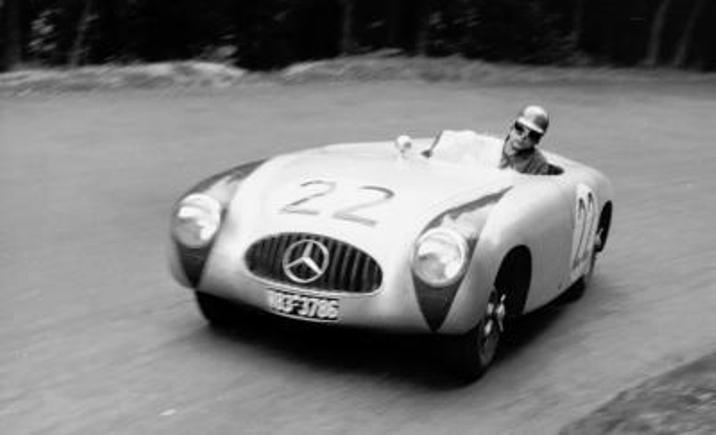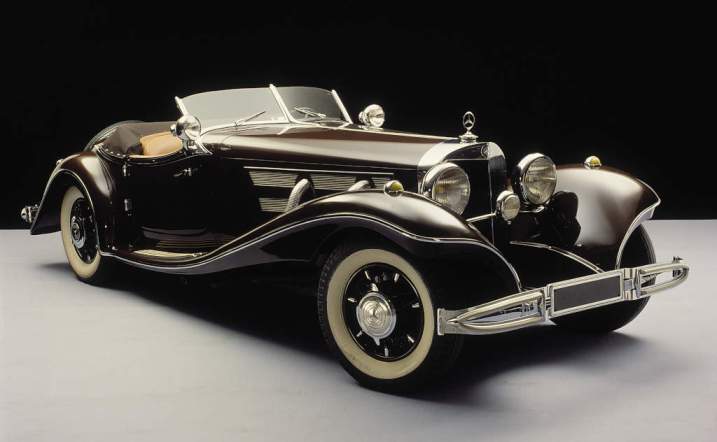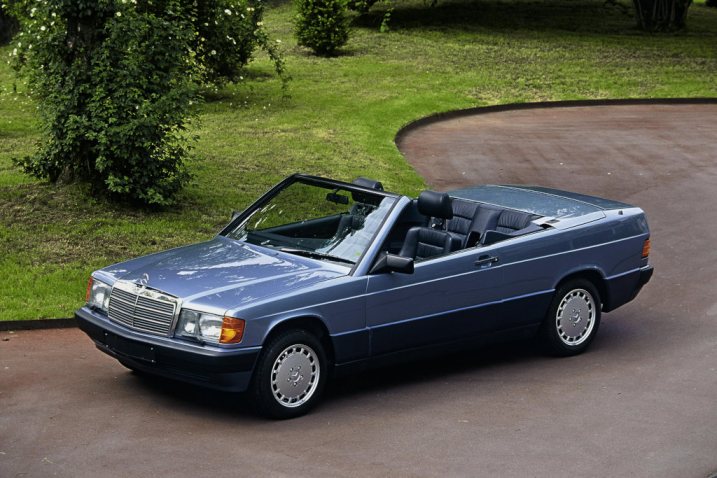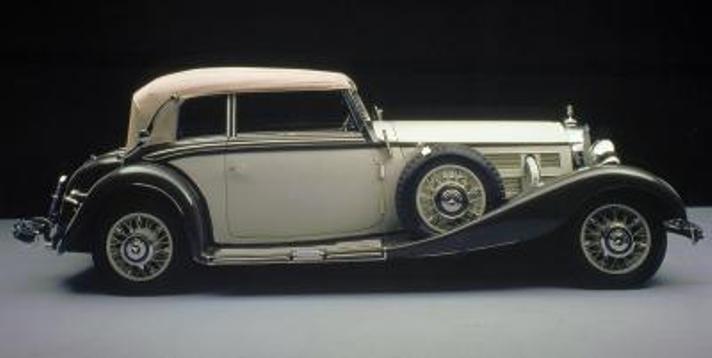
At Techno Classica 2016, Mercedes-Benz Classic will focus on the culture of open-top motoring. In Hall 1 of the show in Essen, the Stuttgart brand will present open-top vehicles in the tradition of the C-Class Cabriolet, S-Class Cabriolet and SL.
Since the automobile was invented 130 years ago, it is, above all, luxurious cabriolets and sporty roadsters from Mercedes-Benz that have inspired the dream of open-top motoring. Even the meticulously crafted, airy architecture of the company’s stand at the show will take up this theme.
The 28th Techno Classica will be held in Essen from 6 to 10 April 2016. Mercedes-Benz Classic’s presence at the event will be rounded off by a stand for the newly established “ALL TIME STARS” vehicle-trading platform as well as by 16 officially recognised Mercedes-Benz brand clubs.
In line with tradition, Mercedes-Benz Classic will, once again in 2016, welcome visitors to Techno Classica in Hall 1. This year, the stand will offer a journey through time, through the fascinating world of the cabriolets and roadsters of the brand with the star. In 1886, when Carl Benz and Gottlieb Daimler invented the automobile independently of each other, an open-top vehicle was still the only form of motoring.
Starting in the 1920s, when car manufacturing began to be dominated by saloons and large-scale production, open-top vehicles evolved into the most exclusive variants of the model line-up, being especially popular among lovers of sportily elegant mobility. Luxurious cabriolets and roadsters from Mercedes-Benz have always met the aspirations of the most discerning customers, for they unite the freedom of open-top motoring with superlative comfort, refined performance and fascinating styling.
The Mercedes-Benz Classic stand at this year’s show will host numerous examples from these special families of vehicles.
The new S-Class Cabriolet (A 217) will be flanked by a 500 K Cabriolet B (W 29, 1934 to 1936), a vehicle of the international luxury class in the 1930s. Unveiled in 1949, the 170 S Cabriolet B is an exclusive vehicle from the early post-war years. The 300 S Roadster (W 188) dates from the 1950s. Premiered at the Paris Motor Show in October 1951, the 300 S was the most expensive German-made passenger car.
Unmistakable characteristics are exhibited also by the elegant cabriolets of the W 111 series, which were the first-ever open-top vehicles to feature a safety body with crumple zones at both front and rear. In autumn 1969, Mercedes-Benz launched the 280 SE 3.5 Cabriolet, a powerful and especially luxurious top-of-the-range model of this series.
Alongside luxurious cabriolets, sportily elegant roadsters have always been a Mercedes-Benz domain. An outstanding example – which will be on view at Techno Classica – is the 500 K Special Roadster (W 29, 1934 to 1936). Coming straight from the world of motorsport, another sporty roadster went into production after the Second World War: the SL.
This magic abbreviation has been in existence since 1952, when Mercedes-Benz made a highly successful return to top-flight international motorsport with the 300 SL racing sports car (W 194). The vehicle proved an outright winner, securing impressive double victories at the 24 Hours of Le Mans and the Carrera Panamericana in Mexico.
The W 194 also gave rise to the famous 300 SL “Gullwing” (W 198) of 1954, which made its debut in spring 1957 in the open-top variant, the 300 SL Roadster. The most recent example of this tradition, unveiled in 2015, is the latest generation of the SL (R 231).
The new C-Class Cabriolet (A 205) was one of the stars at the 2016 Geneva Motor Show. There were similar plans for the compact Mercedes-Benz 190 E (W 201), whereupon a prototype cabriolet was produced in 1990. It, too, will be on show in Essen. Highly successful in terms of both looks and technology, although the vehicle did not go into series production, it served as an important decision-making aid for the series 124 cabriolet unveiled in 1991.
Open-top motoring – a guarantee for high spirits
The term “cabriolet” dates back to the age of the horse-drawn carriage. It refers to a lightweight, open-top carriage drawn by two horses and used especially in fine weather. The name says it all: the French verb “cabrioler” means “to cut a caper”, “to make a playful skipping movement”. In the early years of the automobile, however, open-top motoring, as a guarantee for high spirits, did not yet need a special body design. The period between 1886 and around 1920 was dominated by the open-top automobile.
As the closed body established itself in the first third of the 20th century, coachbuilders responded by offering not only the fixed-body saloon and coupé, but also the cabriolet with a soft top that could be fully folded down. Already in the 1920s, the hallmarks of this style of vehicle were its sporty and elegant lines as well as – in contrast to the widespread open tourer – the option of fully closing the vehicle using the lined soft top, thereby offering the occupants the perfect protection against wind and rain associated with a saloon.
In the years leading up to the Second World War, almost all Mercedes-Benz model series were optionally available in the form of a cabriolet, sometimes in a variety of versions. In 1934, for example, the company brought out the “Model 500 with Kompressor”, abbreviated to 500 K (model series W 29), initially in eight different body versions, including a cabriolet in three variants, a two-door open tourer and a roadster. The situation was to change after the war.
When production resumed with the extensively unchanged 170 V, there were at first no cabriolets rolling off the line. Although they soon once again became available for the most highly powered models in the line-up, the saloon had finally established itself as the standard form of body. From that time forward, the open-top body became something out of the ordinary in the product range.
Mercedes-Benz “ALL TIME STARS”
The newly established “ALL TIME STARS” vehicle-trading platform operated by Mercedes-Benz Museum GmbH will likewise be represented at Techno Classica with its sales offering of high-quality Mercedes-Benz classic cars, both modern classics and vintage vehicles (http://alltime-stars.com). The focus of “ALL TIME STARS” is on classic cars that are fully suitable for everyday driving and which are offered for sale under conditions of the greatest possible transparency.
To ensure this, the experts from Mercedes-Benz Classic subject every vehicle to a comprehensive inspection according to a 160-item checklist. The vehicles on offer are classified into three categories to provide information on condition and authenticity. The “Concours Edition” includes modern classics and vintage vehicles in rare original condition with low mileage as well as vehicles that have been carefully restored by the experts at Mercedes-Benz Classic in Fellbach/Stuttgart.
The “Collectors Edition” comprises vintage vehicles and modern classics that are in excellent condition both technically and visually. Their slight patina lends them a particularly special character. The “Drivers Edition” is aimed at individuals looking for vintage vehicles and modern classics suitable for everyday driving and at people who enjoy working on cars.
These cars are in excellent technical condition while still offering potential for further restoration work. “ALL TIME STARS” reflect the great diversity of the Mercedes-Benz brand over the ages. The range basically includes every car made by Mercedes-Benz and its predecessor brands.
Mercedes-Benz ClassicPartner
ClassicPartner is a network of Mercedes-Benz outlets across Germany that pools the expertise of proven specialists in all matters relating to classic Mercedes-Benz vehicles. These outlets offer high-quality vehicles and optimum service, including the supply of replacement parts. The network currently comprises 25 dealers.
The website www.mercedes-benz.com/classic-partner presents the range of services offered by Mercedes-Benz ClassicPartner and offers a convenient dealer search function. Some ClassicPartners will be present at Techno Classica in Hall 3 with their range of vehicles for sale.
The world’s largest event of its kind
The 28th Techno Classica will be held at the Messe Essen exhibition centre from 6 to 10 April 2016. The “World Show for Vintage, Classic and Prestige Automobiles, Motorsport, Motorcycles, Spare Parts, Restoration and World Club Meeting” ranks as the world’s largest event of its kind. More than 25 car-makers and well over 200 brand clubs will be represented at Techno Classica with their own stands.
In total, the organisers are expecting some 1250 exhibitors and more than 190,000 visitors. Techno Classica will open its doors for “Happy View Day” from 2 p.m. to 8 p.m. on Wednesday, 6 April 2016. From Thursday, 7 April to Sunday, 10 April 2016, the exhibition centre will then be open daily from 9 a.m. to 6 p.m. (Friday: until 7 p.m.).
Mercedes-Benz Classic vehicles at Techno Classica 2016

Mercedes-Benz 500 K Special Roadster (model series W 29, 1934-1936)
Mercedes-Benz dominated the international luxury car market in the 1930s with its eight-cylinder supercharged models. The company brought out the “Model 500 with Kompressor”, abbreviated to 500 K (model series W 29) in 1934. In total, nine different body versions were available: four-door saloon, two-door saloon, two-seater roadster, cabriolets A, B and C, two-door open tourer, Autobahn Kurier and Special Roadster.
Just 29 units of the especially elegant and luxurious Special Roadster were built. All versions of the 500 K and its successor, the 540 K, were destined for iconic status, firstly because of their superlative power delivery and, secondly, thanks to their highly attractive, luxuriously finished coachwork. The precision-tailored design and elegantly flowing lines of the “Sindelfingen body” have since the 1930s been the standard by which others are judged.
Produced: 1934-1936
Cylinders: 8/in-line
Displacement: 5018 cc
Output: 74 kW (100 hp) without supercharger, 118 kW (160 hp) with supercharger
Top speed: 160 km/h
Mercedes-Benz 500 K Cabriolet B (W 29, 1934-1936)
The 500 K – K denoting “Kompressor” (supercharger) – combined unprecedented refinement with what was, by the standards of the day, sensational performance. It could handle crawling traffic with ease and yet, when required, reveal a temperament that simply left the contemporaries of the 500 K in its wake.
Slightly more pressure on the accelerator resulted in a 60 percent boost in output, because this caused the compressor clutch to kick in with the Roots blower forcing air at 0.3 bar into the twin carburettor, thereby unleashing an extra 44 kW(60 hp). As was standard for Mercedes-Benz from the mid-1930s, the available 118 kW (160 hp) was transferred to the road via a swing axle with coil springs. Buyers of the 500 K could choose from no fewer than nine body variants, with the majority opting for the Cabriolet B.
Produced: 1934-1936
Cylinders: 8/in-line
Displacement: 5018 cc
Output: 74 kW (100 hp) without supercharger, 118 kW (160 hp) with supercharger
Top speed: 160 km/h
Mercedes-Benz 170 S Cabriolet B (W 136, 1949-1951)
In May 1949, the Mercedes-Benz passenger-car range, which had since the start of post-war production featured just one model, the 170 V, was augmented by two new models: the 170 D diesel variant and the 170 S, which was more spacious, prestigious and comfortable than the basic model. Alongside the saloon, two luxurious two-door models were available: the Cabriolet B and the even more exclusive Cabriolet A with a 2+2 seating configuration.
As Germany’s “economic miracle” began to take off, both variants stood for superlative automotive luxury. This was apparent from the luxury interior with its high-grade materials and supreme build quality, while also being reflected in the price as well as in the number of units produced. Just 830 examples of the Cabriolet A were manufactured to the end of 1951, with 1603 units of the Cabriolet B being built.
Launched in 1951 as the Model 220, the externally almost identical successor models impressed not only with their luxurious interior, but also with their highly appealing performance thanks to a new 59 kW (80 hp) six-cylinder engine.
Produced: 1949-1951
Cylinders: 4/in-line
Displacement: 1767 cc
Output: 38 kW (52 hp)
Top speed: 120 km/h
Mercedes-Benz 300 SL racing sports car (W 194, 1952)
300 SL was the designation of the competition racing car from Mercedes-Benz with which the brand returned to international motor racing in 1952 for the first time after the Second World War. Following the triumphant double victory at Le Mans and the previous double victory at the Bern Grand Prix, the 300 SL also won the two other races in which it had lined up on the grid.
The 300 SL took the first four places at the Nürburgring Great Jubilee Prize in the weight-reduced roadster version, while the Carrera Panamericana, a gruelling endurance race covering more than 3100 kilometres across Mexico, saw the car finish with a double victory. Karl Kling and Hans Klenk took first place in Mexico despite colliding with a vulture that smashed through the windscreen during the race.
Even though the successful racing sports car was not sold to the public, it did light the fuse for the development of SL standard-production sports cars, which began at the end of 1953.
Production period: 1952
Cylinders: 6/in-line
Displacement: 2996 cc
Output: 125 kW (170 hp)
Top speed: 230 km/h
Mercedes-Benz 300 S Roadster (W 188, 1956-1958)
The 300 S made its debut at the Paris Motor Show in October 1951, touted as the new flagship model of the passenger-car range. The luxurious two-door model, which saw Mercedes-Benz enter the top end of the international market for the first time after the Second World War, was available in coupé, cabriolet and roadster versions from summer 1952.
The roadster version was basically identical to the cabriolet, although its lightweight soft top without storm bars gave it a sportier appearance. In autumn 1955, Mercedes-Benz unveiled a revised version of the 300 S with innovative direct petrol injection, which boosted output by18 kW (25 hp) while at the same time increasing efficiency.
The new variant, which featured the same single-joint swing axle that had proved successful in Formula 1, was known in-house as the 300 Sc. At the time, it came with a price tag of DM36,500, making it the most expensive car produced by a German manufacturer.
By way of comparison: the legendary Mercedes-Benz 300 SL could be bought for DM29,000 in 1956. With just 53 units built, the 300 S Roadster with injection engine is one of the rarest passenger cars from the post-war years.
Produced: 1956-1958
Cylinders: 6/in-line
Displacement: 2996 cc
Output: 129 kW (175 hp)
Top speed: 180 km/h
Mercedes-Benz 300 SL Roadster (W 198, 1957-1963)
Mercedes-Benz unveiled the 300 SL Roadster as the successor to the 300 SL Gullwing Coupé at the Geneva Motor Show in March 1957. At a technical level, the open-top sports car was very like the Coupé, although the modified space frame allowed the installation of conventionally attached doors, which were necessary for open-top driving.
The fabric soft top was convenient to operate in just a few simple steps and disappeared underneath a separate flap behind the seats. From 1958 onwards, the roadster was also available with a detachable coupé roof. It was from the standard-production 300 SL Roadster that the Mercedes-Benz engineers developed the 300 SLS racing variant with which Paul O’Shea was victorious in Category D of the American Sports Car Championship in 1957.
Production of the 300 SL Roadster was discontinued in 1963 after seven years, during which time 1858 units of the highly exclusive sports car were built.
Production period: 1957-1963
Cylinders: 6/in-line
Displacement: 2996 cc
Output: 158 kW (215 hp)
Top speed: up to 250 km/h
Mercedes-Benz 280 SE 3.5 Cabriolet (W 111, 1969-1971)
The Mercedes-Benz 280 SE 3.5 Cabriolet was the flagship model of the W 111 cabriolets made between 1961 and 1971. In terms of both technology and looks, the family of luxurious open-top cars was based on the “Tail Fin” saloons of the W 111 series unveiled in August 1959. The coupé and cabriolet versions likewise featured the same safety body with front and rear crumple zones that had been introduced as a world first in the saloon models.
Alongside the 220 SE and its successor, the 250 SE, the exclusively appointed and powerful 300 SE (W 112) augmented the range of luxury two-door models. The 280 SE having been launched in early 1968, Mercedes-Benz in September 1969 unveiled the 280 SE 3.5 Cabriolet as the new top-of-the-line model. In combination with the as-standard automatic transmission and power steering, the newly developed, both powerful and refined 3.5-litre V8 engine delivered maximum ride comfort.
Optional extras included electric power windows and air conditioning – attributes we today take for granted, but which were at that time a sign of genuine luxury. A price tag of around DM34,000 contributed to the exclusivity of the luxury cabriolet, of which just 1232 units were built in two years. By virtue of its timelessly elegant lines and incomparable combination of comfort and superlative power delivery, the 280 SE 3.5 Cabriolet is one of the most sought-after classic cars of its age.
Produced: 1969-1971
Cylinders: V8
Displacement: 3499 cc
Output: 147 kW (200 hp)
Top speed: 205 km/h

Mercedes-Benz 190 E 2.6 Cabriolet, prototype (W 201, 1990)
Following the facelift of the Mercedes-Benz W 201 series, which was unveiled in 1988, the brand turned its attention to a cabriolet. The result was a road-going prototype that stood out with its four fully-fledged seats and restyled body with a subtly higher, slightly more angular rear end, where the large folding top was concealed under a metal lid. The two-door cabriolet also boasted an elegant side line even with the roof closed.
Although the car ultimately failed to make it into series production, the concept vehicle served as a decision-making aid on the way to the larger 124 series cabriolet, which was unveiled in 1991 and was one of the forebears of the current E-Class Cabriolet.
The compact cabriolet prototype came with a 2.6-litre six-cylinder engine, which was in tune with the sporty, exclusive aspirations of the open-top two-seater. The same powerplant was available in the 201 series from 1985, propelling the most powerful model in the compact class after the “16-valve engine”.
Production period: 1990
Cylinders: 6/in-line
Displacement: 2597 cc
Output: 122 kW (166 hp) at 5800 rpm
Mercedes-Benz C-Class Cabriolet (A 205, since 2016)
The new C-Class Cabriolet had its premiere at the 86th Geneva International Motor Show in February 2016. It is the first standard-production cabriolet in the history of the Mercedes-Benz C-Class, which began with the W 201 (“190 series”) in 1982. The Cabriolet is a close relative of the C-Class Coupé (C 205), whose silhouette it adopts along with the striking front end featuring a diamond radiator grille, LED High Performance headlamps, long bonnet and high beltline.
The soft top with glass window makes a harmonious transition into the distinctly styled rear end with its highly sporty look. With a capacity of 360 litres (285 litres with the roof open), the boot is capable of holding an exceptional amount of luggage for a cabriolet, thus offering high everyday practicality. With its high-grade materials, the C-Class Cabriolet provides a refreshingly new interpretation of the familiar interior of the C-Class Saloon.
Added to this is a comprehensive package of assistance systems for safety and comfort – through to solutions for semi-autonomous driving. Optional extras include the automatic AIRCAP draught-stop and AIRSCARF neck-level heating, which extend the open-air season to 365 days a year. Several different engines will be available for the market launch in summer 2016. The performance model is the C 63 Cabriolet.
Cylinders: 4/in-line to V6
Displacement: 1595 to 3982 cc
Output: 115 kW (156 hp) to 375 kW (510 hp)
Top speed: 250 km/h (electronically limited)
Combined fuel consumption: 9.3-4.5 l/100 km*
CO2 emissions: 218-116 g/km*
Efficiency classes (Germany): E-A+
Mercedes-Benz S-Class Cabriolet (A 217, since 2016)
Mercedes-Benz unveiled the new S-Class Cabriolet, which is due for market launch in spring 2016, back in autumn 2015. It is Mercedes-Benz’s first open-top luxury four-seater since 1971, when production of the W 111 series luxury cabriolets was discontinued.
The A 217 model series boasts an unmistakable, sensual and exclusive design, which combines the cutting-edge technology of the current S-Class with an extensive heat and wind protection concept as well as intelligent climate control for cabriolets. The outstanding ride comfort in the S-Class is largely down to its very stiff construction, incorporating innovative solutions such as a luggage compartment firewall made of aluminium and magnesium as well as a rear section constructed of aluminium.
At the same time, this use of lightweight materials limits the vehicle’s bodyshell weight to that of the S-Class Coupé. The standard-fit roll-over protection system behind the rear head restraints features pyrotechnic initiation of the actuators for the first time, in addition to which the roll bars themselves are moved into position by a gas generator. The soft top can be opened and closed while driving at speeds up to 60 km/h.
Cylinders: V8 (S 500) to V 12 (S 65)
Displacement: 4663 to 5980 cc
Output: 335 kW (455 hp) to 463 kW (630 hp)
Top speed: 250 km/h (electronically limited)
Combined fuel consumption: 10.4-8.5 l/100 km
CO2 emissions: 244-199 g/km
Efficiency classes (Germany): E-C
Mercedes-Benz SL Roadster (R 231, since 2016)
The technically and visually revised SL (R 231) was premiered at the Los Angeles Auto Show in November 2015. The facelifted roadster is due to be launched in April 2016. The new SL marks the continuation of Mercedes-Benz’s unique tradition of elegant sportiness, which began with the motorsport-inspired 300 SL in the 1950s. Compared with the first version of the R 231 unveiled in 2012, the new SL boasts an even more dynamic design and more powerful engines.
Furthermore, the 9G-TRONIC automatic transmission, DYNAMIC SELECT with five transmission modes and Active Body Control with curve tilting function elevate the roadster’s ride comfort and sportiness to new levels. The soft top, which can now be operated at up to 40 km/h, and the automatic boot separator are additional amenities that further enhance the convenient user-friendliness of this luxury sports car.
Cylinders: V6 (SL 400) to V12 (SL 65)
Displacement: 2996 to 5980 cc
Output: 270 kW (367 hp) to 463 kW (630 hp)
Top speed: 250 km/h (electronically limited)
Combined fuel consumption: 11.9-7.7 l/100 km
CO2 emissions: 279-175 g/km
Efficiency classes (Germany): G-D






































